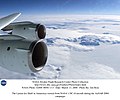File:View over an DC-8 wing with CFM-56 engines to antarctica.jpg

原始檔案 (2,889 × 1,900 像素,檔案大小:2.53 MB,MIME 類型:image/jpeg)
說明
說明
摘要
[編輯]The Larsen Ice Shelf in Antarctica viewed from NASA's DC-8 aircraft during the AirSAR 2004 campaign.
Photo Number: ED04-0056-113 Photo Date: March 13, 2004
Formats: 578x480 JPEG Image (138 KBytes) 1233x1024 JPEG Image (509 KBytes) 2889x2400 JPEG Image (2419 KBytes)
Photo Description: The Larsen Ice Shelf in Antarctica viewed from NASA's DC-8 aircraft during the AirSAR 2004 campaign. AirSAR 2004 is a three-week expedition in Central and South America by an international team of scientists that is using an all-weather imaging tool, called the Airborne Synthetic Aperture Radar (AirSAR), located onboard NASA's DC-8 airborne laboratory. Scientists from many parts of the world are combining ground research with NASA's AirSAR technology to improve and expand on the quality of research they are able to conduct.
These photos are from the DC-8 aircraft while flying an AirSAR mission over Antarctica. The Antarctic Peninsula is more similar to Alaska and Patagonia than to the rest of the Antarctic continent. It is drained by fast glaciers, receives abundant precipitation, and melts significantly in the summer months. In recent decades, the Peninsula has experienced significant atmospheric warming (about 2 degrees C since 1950), which has triggered a vast and spectacular retreat of its floating ice shelves, glacier reduction, a decrease in permanent snow cover and a lengthening of the melt season. As a result, the contribution to sea level from this region could be rapid and substantial. With an area of 120,000 km, or ten times the Patagonia ice fields, the Peninsula could contribute as much as 0.4mm/yr sea level rise, which would be the largest single contribution to sea level from anywhere in the world.
This region is being studied by NASA using a DC-8 equipped with the Airborne Synthetic Aperture Radar developed by scientists from NASA’s Jet Propulsion Laboratory. AirSAR will provide a baseline model and unprecedented mapping of the region. This data will make it possible to determine whether the warming trend is slowing, continuing or accelerating. AirSAR will also provide reliable information on ice shelf thickness to measure the contribution of the glaciers to sea level.
Project Description: AirSAR collects multi-frequency and multi-polarization radar data for a variety of science applications. It also acquires data in interferometric modes, providing topographic information (cross-track mode) or ocean current information (along-track interferometry). This March 2004 deployment was planned to:
* Study the extent and distribution of archeological Mayan civilization (using foliage-penetrating radar) * Study the glaciers of Patagonia and the Antarctic peninsula * Investigate new techniques for the measurement of the forest structure of dense tropical forests * Fill in the largest "void" in the SRTM-derived map of South American topography * Collect additional data for various research initiatives
During the deployment data is collected over Central and South America and Antarctica. During the approximately 100 flight hours, AirSAR is acquiring polarimetric and/or interferometric data along a 20,000 km track, or about 200,000 sq. km of data over 40 sites for 30 scientists. AirSAR will collect data related to the following NASA Code YS science programs:
* Cryospheric Science * Land Cover/Land Use Change * Natural Hazards * Physical Oceanography * Terrestrial Ecology * Hydrology
NASA used a DC-8 aircraft as a flying science laboratory. The platform aircraft, was based at NASA's Dryden Flight Research Center, Edwards, Calif., collected data for many experiments in support of scientific projects serving the world scientific community. Included in this community were NASA, federal, state, academic and foreign investigators. Data gathered by the DC-8 at flight altitude and by remote sensing has been used for scientific studies in archeology, ecology, geography, hydrology, meteorology, oceanography, volcanology, atmospheric chemistry, soil science and biology.
NASA Photo by: Jim Ross
Keywords: DC-8, airborne science, airborne laboratory, AirSAR, Airborne Synthetic Aperture Radar, South America, Chile, Patagonia, Antarctic Peninsula, Antarctica
source:http://www1.dfrc.nasa.gov/Gallery/Photo/DC-8/HTML/ED04-0056-113.html
授權條款
[編輯]| Public domainPublic domainfalsefalse |
| 本作品由NASA創作,屬於公有領域。根據NASA的版權政策:“NASA的創作除非另有聲明否則不受版權保護。”(參見:Template:PD-USGov/zh,NASA版權政策或JPL圖像使用政策) |  | |
 |
警告:
|
檔案歷史
點選日期/時間以檢視該時間的檔案版本。
| 日期/時間 | 縮圖 | 尺寸 | 使用者 | 備註 | |
|---|---|---|---|---|---|
| 目前 | 2008年3月12日 (三) 16:21 |  | 2,889 × 1,900(2.53 MB) | EraserGirl(留言 | 貢獻) | rmv caption |
| 2006年12月20日 (三) 14:20 |  | 2,889 × 2,400(2.36 MB) | Uwe W.(留言 | 貢獻) | The Larsen Ice Shelf in Antarctica viewed from NASA's DC-8 aircraft during the AirSAR 2004 campaign. Photo Number: ED04-0056-113 Photo Date: March 13, 2004 Formats: 578x480 JPEG Image (138 KBytes) 1233x1024 JPEG Image (509 KBytes) 2889x2400 JPE |
無法覆蓋此檔案。
檔案用途
下列頁面有用到此檔案:
全域檔案使用狀況
以下其他 wiki 使用了這個檔案:
- azb.wikipedia.org 的使用狀況
- de.wikipedia.org 的使用狀況
- fr.wikipedia.org 的使用狀況
- hr.wikipedia.org 的使用狀況
- no.wikipedia.org 的使用狀況
- pl.wikipedia.org 的使用狀況
- ru.wikipedia.org 的使用狀況
- sr.wikipedia.org 的使用狀況
- zh.wikipedia.org 的使用狀況
詮釋資料
此檔案中包含其他資訊,這些資訊可能是由數位相機或掃描器在建立或數位化過程中所新增的。若檔案自原始狀態已被修改,一些詳細資料可能無法完整反映出已修改的檔案。
| 相機製造商 | Kodak |
|---|---|
| 方位 | 標準 |
| 水平解析度 | 300 dpi |
| 垂直解析度 | 300 dpi |
| 使用軟體 | Adobe Photoshop 7.0 |
| 檔案修改日期時間 | 2008年3月12日 (三) 12:20 |
| 色彩空間 | 顏色未校準 |